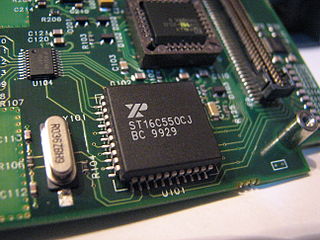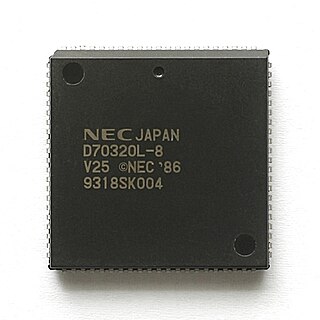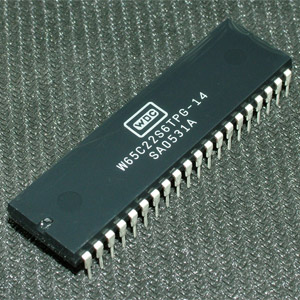
In digital computers, an interrupt is an input signal to the processor indicating an event that needs immediate attention. An interrupt signal alerts the processor and serves as a request for the processor to interrupt the currently executing code, so that the event can be processed in a timely manner. If the request is accepted, the processor responds by suspending its current activities, saving its state, and executing a function called an interrupt handler to deal with the event. This interruption is temporary, and, unless the interrupt indicates a fatal error, the processor resumes normal activities after the interrupt handler finishes.

A microcontroller is a small computer on a single metal-oxide-semiconductor (MOS) integrated circuit chip. In modern terminology, it is similar to, but less sophisticated than, a system on a chip (SoC); an SoC may include a microcontroller as one of its components. A microcontroller contains one or more CPUs along with memory and programmable input/output peripherals. Program memory in the form of ferroelectric RAM, NOR flash or OTP ROM is also often included on chip, as well as a small amount of RAM. Microcontrollers are designed for embedded applications, in contrast to the microprocessors used in personal computers or other general purpose applications consisting of various discrete chips.

The 16550 UART is an integrated circuit designed for implementing the interface for serial communications. The corrected -A version was released in 1987 by National Semiconductor. It is frequently used to implement the serial port for IBM PC compatible personal computers, where it is often connected to an RS-232 interface for modems, serial mice, printers, and similar peripherals. It was the first serial chip used in the IBM PS/2 line, which were introduced in 1987.
A universal asynchronous receiver-transmitter is a computer hardware device for asynchronous serial communication in which the data format and transmission speeds are configurable. The electric signaling levels and methods are handled by a driver circuit external to the UART. A UART is usually an individual integrated circuit (IC) used for serial communications over a computer or peripheral device serial port. One or more UART peripherals are commonly integrated in microcontroller chips. A related device, the universal synchronous and asynchronous receiver-transmitter (USART) also supports synchronous operation.

In computing, a serial port is a serial communication interface through which information transfers in or out sequentially one bit at a time. This is in contrast to a parallel port which communicates multiple bits simultaneously in parallel. Throughout most of the history of personal computers, data was transferred through serial ports to devices such as modems, terminals, and various peripherals.

The Freescale 683xx is a family of compatible microcontrollers that use a Motorola 68000-based CPU core. The family was designed using a hardware description language, making the parts synthesizable, and amenable to improved fabrication processes, such as die shrinks.

The MSP430 is a mixed-signal microcontroller family from Texas Instruments. Built around a 16-bit CPU, the MSP430 is designed for low cost and, specifically, low power consumption embedded applications.

The Pot Keyboard Integrated Circuit (POKEY) is a digital I/O chip designed for the Atari 8-bit family of home computers and found in Atari arcade games of the 1980s. POKEY combines functions for sampling (ADC) potentiometers and scan matrices of switches as well as sound generation. It produces four voices of distinctive square wave sound, either as clear tones or modified with a number of distortion settings. POKEY chips are used for audio in many arcade games including Centipede, Missile Command, Asteroids Deluxe, and Gauntlet. Some of Atari's arcade systems use multi-core versions with 2 or 4 POKEY chips in a single package for more sound voices. The Atari 7800 console allows a game cartridge to contain a POKEY, providing better sound than the system's audio chip. Only two licensed games make use of this: the ports of Ballblazer and Commando.

1-Wire is a device communications bus system designed by Dallas Semiconductor Corp. that provides low-speed data, signaling, and power over a single conductor.

The Blackfin is a family of 16-/32-bit microprocessors developed, manufactured and marketed by Analog Devices. The processors have built-in, fixed-point digital signal processor (DSP) functionality supplied by 16-bit multiply–accumulates (MACs), accompanied on-chip by a microcontroller. It was designed for a unified low-power processor architecture that can run operating systems while simultaneously handling complex numeric tasks such as real-time H.264 video encoding.

The Intel 8253 and 8254 are Programmable Interval Timers (PITs), which perform timing and counting functions using three 16-bit counters.
In computer science, a data buffer is a region of a physical memory storage used to temporarily store data while it is being moved from one place to another. Typically, the data is stored in a buffer as it is retrieved from an input device or just before it is sent to an output device. However, a buffer may be used when moving data between processes within a computer. This is comparable to buffers in telecommunication. Buffers can be implemented in a fixed memory location in hardware—or by using a virtual data buffer in software, pointing at a location in the physical memory. In all cases, the data stored in a data buffer are stored on a physical storage medium. A majority of buffers are implemented in software, which typically use the faster RAM to store temporary data, due to the much faster access time compared with hard disk drives. Buffers are typically used when there is a difference between the rate at which data is received and the rate at which it can be processed, or in the case that these rates are variable, for example in a printer spooler or in online video streaming. In the distributed computing environment, data buffer is often implemented in the form of burst buffer that provides distributed buffering service.
In computer engineering and electrical engineering, bit banging is slang for various techniques for data transmission in which software is used to generate and process signals instead of dedicated hardware. Software directly sets and samples the state of pins on a microcontroller, and is responsible for all parameters of the signal: timing, levels, synchronization, etc. In contrast to bit banging, dedicated hardware handles these parameters and provides a (buffered) data interface in other systems, so software is not required to perform signal demodulation. Bit banging can be implemented at very low cost, and is used in embedded systems.

The NEC V25 (μPD70320) was the microcontroller version of the NEC V20 processor. Features included:

The 8250 UART is an integrated circuit designed for implementing the interface for serial communications. The part was originally manufactured by the National Semiconductor Corporation. It was commonly used in PCs and related equipment such as printers or modems. The 8250 included an on-chip programmable bit rate generator, allowing use for both common and special-purpose bit rates which could be accurately derived from an arbitrary crystal oscillator reference frequency.

The 6526/8520 Complex Interface Adapter (CIA) was an integrated circuit made by MOS Technology. It served as an I/O port controller for the 6502 family of microprocessors, providing for parallel and serial I/O capabilities as well as timers and a Time-of-Day (TOD) clock. The device's most prominent use was in the Commodore 64 and Commodore 128(D), each of which included two CIA chips. The Commodore 1570 and Commodore 1571 floppy disk drives contained one CIA each. Furthermore, the Amiga home computers and the Commodore 1581 floppy disk drive employed a modified variant of the CIA circuit called 8520. 8520 is functionally equivalent to the 6526 except for the simplified TOD circuitry.

The Western Design Center (WDC) W65C134S microcontroller is a complete fully static 8-bit computer fabricated on a single chip using a low power CMOS process. The W65C134S complements an established and growing line of 65xx products and has a wide range of microcomputer applications. The W65C134S has been developed for Hi-Rel applications, and where minimum power is required.

The W65C22 versatile interface adapter (VIA) is an input/output device for use with the 65xx series microprocessor family. Designed by the Western Design Center, the W65C22 is made in two versions, both of which are rated for 14 megahertz operation, and available in DIP-40 or PLCC-44 packages.

The Parallax P8X32A Propeller is a multi-core processor parallel computer architecture microcontroller chip with eight 32-bit reduced instruction set computer (RISC) central processing unit (CPU) cores. Introduced in 2006, it is designed and sold by Parallax, Inc.
When writing firmware for an embedded system, immunity-aware programming refers to programming techniques which improve the tolerance of transient errors in the program counter or other modules of a program that would otherwise lead to failure. Transient errors are typically caused by single event upsets, insufficient power, or by strong electromagnetic signals transmitted by some other "source" device.















